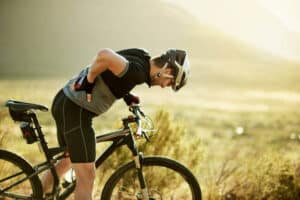
Bonking, also known as hitting the wall, is a dreaded experience for cyclists. It occurs when your body depletes its glycogen stores, leading to a sudden drop in energy levels. To avoid this phenomenon during your biking adventures, it’s crucial to maintain proper nutrition, hydration, and pacing. In this blog post, we’ll discuss effective strategies to prevent bonking while biking and provide essential tips for recovery, including the right food choices, hydration techniques, and overall preparation to keep you fueled and energized on the road.
- Fueling for the Ride: Avoiding bonking starts with proper fueling before and during your bike ride. Consume a balanced meal with carbohydrates, proteins, and healthy fats about 2-3 hours before your ride to ensure sufficient energy reserves. During the ride, aim to consume easily digestible carbohydrates every 30-45 minutes to maintain a steady blood sugar level. Snacks like energy bars, bananas, and sports gels can provide quick energy boosts.
- Hydration for Endurance: Staying hydrated is crucial to prevent bonking. Dehydration can accelerate fatigue and reduce your cycling performance. Start hydrating well before your ride and continue sipping fluids throughout. Water is essential, but for longer rides, consider electrolyte-rich sports drinks to replenish vital minerals lost through sweat. Monitor your fluid intake and drink according to your thirst level to maintain optimal hydration.
- Pacing and Resting: Proper pacing is key to conserving energy and avoiding sudden energy crashes. Pace yourself based on the distance and intensity of your ride. Avoid pushing too hard in the beginning, as it can quickly deplete your glycogen stores. Break your ride into manageable sections, incorporating short rest stops to refuel and recover. Allow your body time to rest and recharge during these breaks, especially during longer rides.
- Recovery Nutrition: After a ride, prioritize post-workout recovery nutrition to replenish depleted glycogen stores and aid muscle repair. Consume a combination of carbohydrates and proteins within 30-60 minutes of finishing your ride. This could include a balanced meal with lean proteins, whole grains, and vegetables or a recovery shake specifically formulated for athletes. Including some healthy fats and antioxidants in your post-ride meal can also aid in reducing inflammation and promoting overall recovery.
- Listen to Your Body: Everyone’s body and cycling needs are different, so it’s essential to listen to your own cues. Pay attention to how you feel during your rides. If you start to feel sluggish or fatigued, it may be a sign that you need to refuel or hydrate. Experiment with different snacks and drinks to find what works best for you and your body’s needs. Additionally, consider working with a sports nutritionist or a cycling coach who can provide personalized guidance based on your specific goals and training regimen.
Bonking can be a cyclist’s worst nightmare, but with proper preparation and fueling strategies, it can be avoided. By focusing on pre-ride fueling, hydration, pacing, and recovery nutrition, you can maintain optimal energy levels and enjoy your biking adventures without hitting the wall. Remember to listen to your body, adjust your nutrition and hydration plan accordingly, and seek professional guidance when needed. With these tips, you’ll be better equipped to stay energized and perform at your best on every cycling journey.


